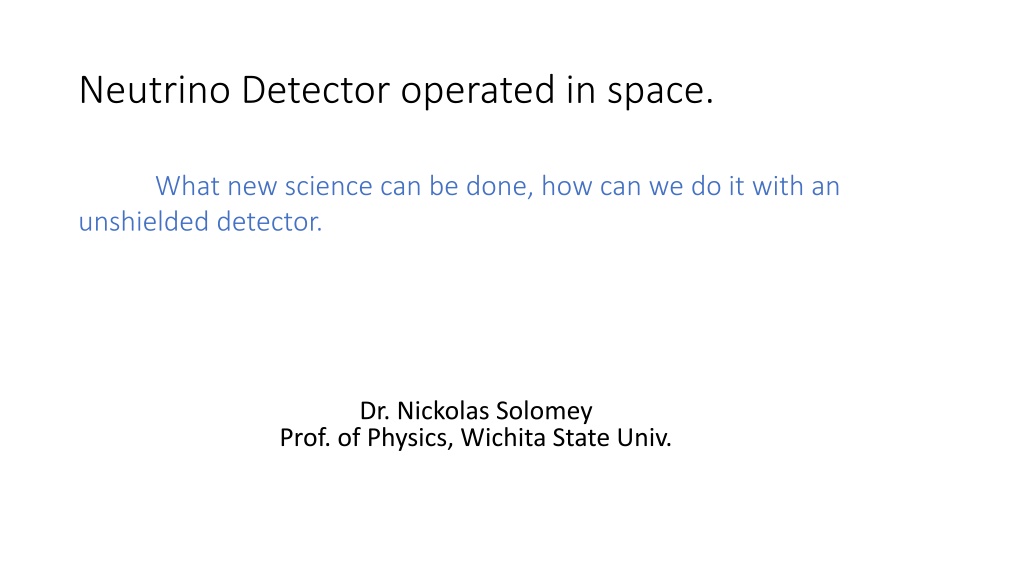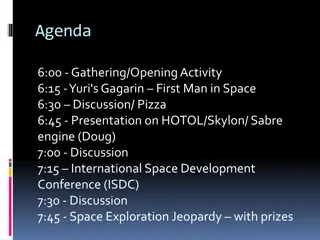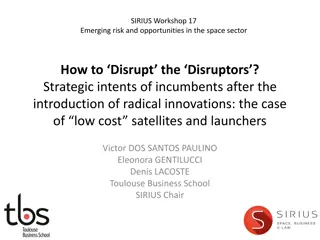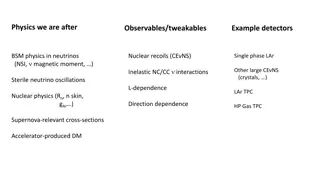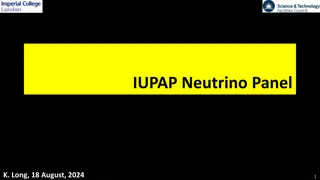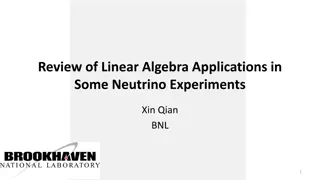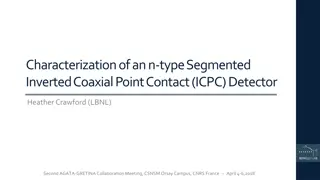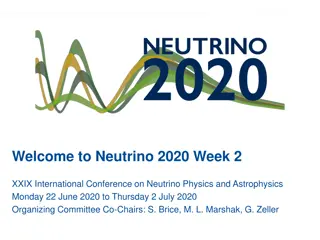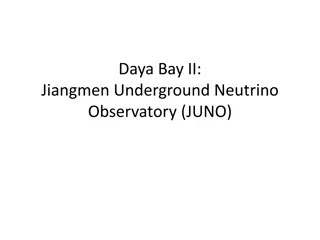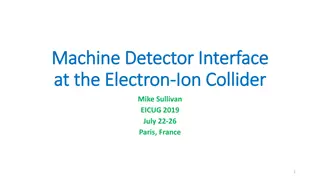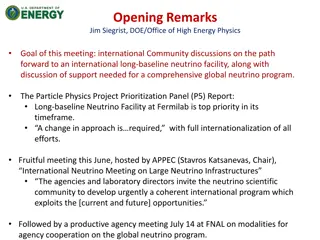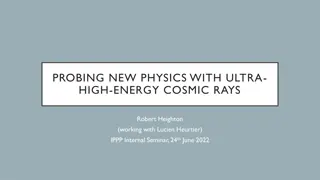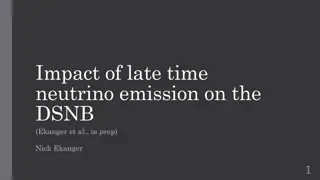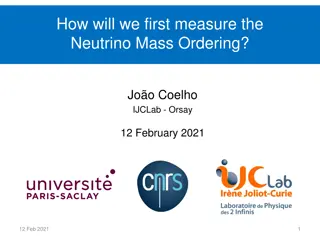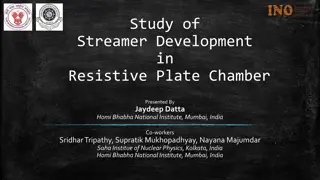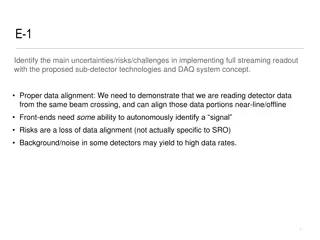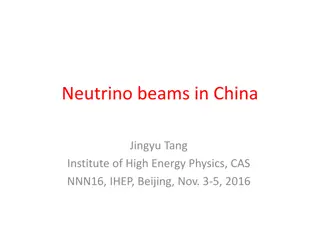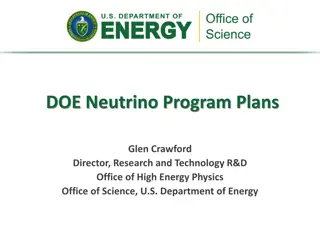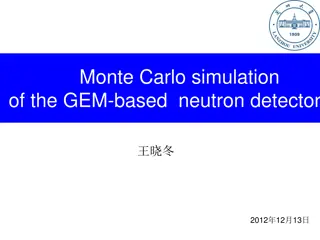Exploring Neutrino Science in Space with Unshielded Detector - Opportunities and Innovations
The deployment of a neutrino detector in space presents a unique opportunity to conduct groundbreaking scientific research, leveraging the intense neutrino flux closer to the Sun. Key areas of focus include studying rare fusion neutrinos, observing neutrino oscillations during spacecraft transitions, and examining the coherence of solar neutrino flavors. By using an unshielded detector, scientists can explore solar fusion processes, measure fusion core sizes, and investigate dark matter interactions within the Sun's core. Furthermore, techniques like double delayed coincidence can be utilized for detecting neutrino interactions amidst cosmic and gamma ray backgrounds. This initiative promises to enhance our understanding of neutrino physics and offer insights into fundamental aspects of solar dynamics.
Download Presentation

Please find below an Image/Link to download the presentation.
The content on the website is provided AS IS for your information and personal use only. It may not be sold, licensed, or shared on other websites without obtaining consent from the author. Download presentation by click this link. If you encounter any issues during the download, it is possible that the publisher has removed the file from their server.
E N D
Presentation Transcript
Neutrino Detector operated in space. What new science can be done, how can we do it with an unshielded detector. Dr. Nickolas Solomey Prof. of Physics, Wichita State Univ.
Neutrino Intensity can change dramatically with distance from the Sun as 1/r2. at 7 solar radii where NASA Parker Space probe currently orbits that is 1000x more than on Earth at 3 solar radii where NASA thinks it can work that would be 10,000x more neutrinos than at Earth.
Unique Science with Neutrino Space Detector. Heliophysics 1. Closer to Sun for rare fusion neutrinos 2. Off the ecliptic plan for polar orbit view 3. Measure size of fusion core 4. Dark matter trapped in core of Sun displacing fusion Particle Physics 1. Observe electron neutrino disappearance vs distance as space craft enters and leaves coherent/de-coherent transition.
Study Solar Nuclear Core: By going close to the Sun it not only increases the neutrino flux and improves the signal to noise ratio, but allows a platform for new Science studying neutrino transition between coherent and de-coherent. Science: Rare neutrino fusion and better understand of current fusion neutrino processes. At Earth the neutrino oscillations are coherent, but closer than 35 solar radii solar neutrino flavors are incoherent, changing their ratio to each other with distance from the sources Neutrino Energy (MeV) Oscillatio n length (km) 34 Coherence Length (km) 2.44x1053.15x10- x (cm) 1 9 6.10x1063.15x10- 5 170 9 2.44x1073.15x10- 10 340 9
A double delayed coincidence can operate unshielded in space. Monte-Carlo simulation of neutrino interaction, galactic cosmic and gamma ray backgrounds mixed with proper ratio and then reconstructed looking for double delayed coincidence with 2nd pulse having a signature energy. This had 10% fake events and the reconstruction shows expected half-life decay curve.
Gravitational Lensing of Galactic Core Distant object Sun For Light the gravitational focus is 550 to 700 AU. [1] A. Einstein, Lens-Like Action of a Star by the Deviation of Light in the Gravitational Field, Science, Vol. 84 (1936), p. 506. [2] M. J. Dulude et al., WFC3 HST STSI Instrument Science Report, 2011-04, Feb. 2011. [3] G.A. Landis, Mission to the Gravitational Focus of the Sun: A Critical Analysis, 23 April 2016, arXiv:1604.06351v2 [astro-ph.EP]. [4] S.G. Turyshev and B-G. Andersson, The 550-AU Mission: a critical discussion , Mon. Not. R. Astron. Soc. 341, pp. 577-582 (2003).
Hubble has some nice images of accidental alignment:
Gravitational Lensing Galactic Core Sun Neutrinos have mass their Neutrino Gravitational Focus is much closer, 20 to 45 AU. Rough estimate is 800x to 8000x solar neutrino rate at Earth for Stellar Galactic core. Y. Demkov and A. Puchkov, Gravitational focusing of cosmic neutrinos by the solar interior, Phys. Rev. D v61, 083001.
Using the 2nd brightest neutrino source in sky, the galactic core and Neutrino Grava tonal Focus here is a simulation of 500 kg neutrino detector as it moves away from Earth opposite the galactic core. Science goals: Image galactic core in neutrinos, stellar fusion and high energy accretion disks. Use the location of neutrino gravitational focus to measure mass of electron neutrino.
Conclusion: There is unique new science that can be done Close to Sun to better understand Heliophysics Particle physics of coherent/de-coherent transition Dark matter in core of Sun At galactic focus of the Neutrino Gradational Focus A detection method was developed and lab tests are under way
